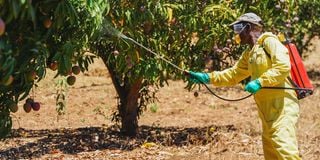Premium
Campaign on proper use of crop pesticides launched

Anthony Kimeu prepares a pesticide before heading to his farm to spray his mango plantation. A a campaign to create awareness on proper use of pesticides has been launched.
Farms in Makueni County are characterised by mango plantations, with the crop being at different stages of development. Some are flowering while others have rather young fruits and others are bigger, probably ready for harvest in a few weeks.
As we are made to understand, the variation in stages of development is a result of different weather conditions and the varieties of mangoes planted.
In Matiliku village, we meet Anthony Kimeu, a farmer whose farm is dotted with mangoes, oranges and some papaya fruits.
He is preparing to spray his mangoes against powdery mildew, which he says has been a menace to many farmers in the area.
Kimeu is not just a farmer but also a spray service provider, serving over 300 farms within his village and others in the neighbouring counties of Machakos and Kajiado.
But on this day, he is not just spraying his crop but also demonstrating proper application of pesticides.
In his company are officers from Pest Control Products Board (PCPB) and Agrochemicals Association of Kenya (AAK) and Market Access Upgrade Program (Markup) Kenya.
PCPB is the government institution in charge of regulating importation, exportation, manufacture, distribution and safe use of control products.
AAK on the other hand is the umbrella organisation for manufacturers, formulators, re-packers, importers, distributors and users of pest control products.

Anthony Kimeu spraying his mango crop.
Promote food safety
Funded by the European Union (EU), Markup Kenya is a four-year programme which seeks to promote food safety and market access for selected value chains. The programme is implemented by the United Nations Industrial Development Organisation (Unido) in partnership with the government and the private sector.
The three, together with other partners, have launched a campaign to create awareness on proper use of pesticides, targeting farmers and agro dealers in a bid to enhance food safety and market access.
As should be, the farmer starts by wearing his personal protective equipment which includes goggles, gloves, a face mask, overall and gumboots.
He then inspects his spraying equipment to ensure there is no leakage before carefully reading instructions on the pesticide’s label.
Kimeu measures the right amount of pesticide as recommended on the label and mixes it with some little water in a mixing bucket.
He rinses the container thrice before pouring all the mixture into his knapsack sprayer and mixing it with water as instructed on the label.
Kimeu mixes this mixture thoroughly and heads to spay his mangoes, ensuring the nozzle is half-a-meter from the crop to avoid drift, while keeping constant pressure on the knapsack sprayer and walking at a stable pace.
Having sprayed his fruits, it is time to dispose the pesticides containers.
The farmer punctures the triple rinsed empty bottle and flattens it before putting it in a safe bag awaiting transportation to a collection point based at a nearby upcoming shopping centre.
Collect empty containers
Part of the proposals in the Solid Waste Management Bill, which is currently in Parliament. requires that chemical-manufacturing companies and other manufacturers should be collecting empty containers from farmers.
Farmers should not reuse containers for domestic purposes as they may still have toxic residues.
Additionally, they should not throw them in pit latrines as residues may kill microorganism and insects. They should also not be burnt.
The containers should also not be buried as remnants drain into the soil when it rains.
“Horticulture is the main consumer of agrochemicals and we must therefore emphasise on practices that ensure safety for all, starting with the farmers, right to the consumers,” says Benson Ngigi, the stewardship manager at AAK.
Challenges in pesticides use
Some of the common challenges in pesticides use, he adds, are use of under doses, use of wrong application equipment and poor choice of pesticides for specific crops. Listed pesticides are usually available at authorised agro outlets.
Some markets like the lucrative EU, Ngige notes, have a list of recommended chemicals and farmers should know which are allowed for what crop.
PCPB’s Compliant and Enforcement Officer Nicolas Muendo says there are three aspects of safety while using pesticides.
One is safety of the farmer, especially considering that pesticides are hazardous. The other one is the safety to the environment because pesticides can kill non-target crops, insects and animals if this is not put into consideration.
The aspect of crop safety ensures there is no phyto-toxicity and this is achieved by using pesticides that are authorised.
The campaign will target farmers and pesticides dealers under the slogan ‘Dawa bora mazao bora’ (Proper pesticides for good yields).





